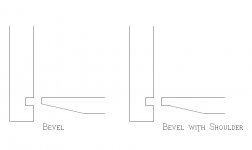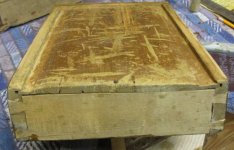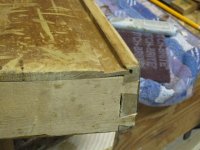rchampagne
Well-known member
Hi All,
I have been involved in a discussion on another forum regarding drawer bottoms. One of the more experienced woodworkers on that site answered a question about how a dovetailed drawer should be built, and showed a picture of a drawer he had made recently. The drawer bottom was chamfered and slid into grooves in the drawer side. I have seen a lot of drawers done this way in period originals. However, he had used a panel raising shaper cutter to bevel the bottom, leaving a square edge to engage in the groove. I posted that while I appreciated that this method should work fine, that I had never seen an antique drawer made this way, and that a plain beveled edge fit into the groove was one of the more common ways drawer bottoms had been made in the 18th century. Another poster commented that to make a drawer bottom with just a bevel (withouth the square edge) would result in a weaker drawer, and that leaving off the squared edge was likely something done in factories. My question here is, has anyone seen an antique drawer bottom made in the method I have described, ie, bevelled but with a square edge? I am unaware of any period examples. Hopefully I have explained this with clarity.
Thanks,
Rob
I have been involved in a discussion on another forum regarding drawer bottoms. One of the more experienced woodworkers on that site answered a question about how a dovetailed drawer should be built, and showed a picture of a drawer he had made recently. The drawer bottom was chamfered and slid into grooves in the drawer side. I have seen a lot of drawers done this way in period originals. However, he had used a panel raising shaper cutter to bevel the bottom, leaving a square edge to engage in the groove. I posted that while I appreciated that this method should work fine, that I had never seen an antique drawer made this way, and that a plain beveled edge fit into the groove was one of the more common ways drawer bottoms had been made in the 18th century. Another poster commented that to make a drawer bottom with just a bevel (withouth the square edge) would result in a weaker drawer, and that leaving off the squared edge was likely something done in factories. My question here is, has anyone seen an antique drawer bottom made in the method I have described, ie, bevelled but with a square edge? I am unaware of any period examples. Hopefully I have explained this with clarity.
Thanks,
Rob



